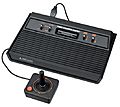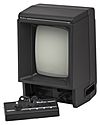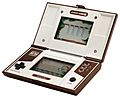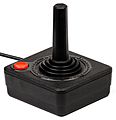History of video game consoles (second generation) facts for kids
The second generation of video game consoles started in 1976. This was a time when home video games were becoming more popular. The first consoles of this generation were the Fairchild Channel F and the Radofin Electronics' 1292 Advanced Programmable Video System. People sometimes call this period the "early 8-bit era" because of the way the consoles processed information.
Many different consoles were released during this time. The Atari 2600 was the most famous and popular console for a big part of this generation. Other well-known consoles included the Intellivision, the Odyssey 2, and the ColecoVision.
The second generation of video game consoles ended in 1984. This happened because of a big problem in the video game world called the video game crash of 1983. It was a tough time for video game companies, and many stopped making games or consoles.
Even with the crash, some consoles sold very well. The Atari 2600 sold an amazing 30 million units! The Intellivision sold 3 million units, and the ColecoVision sold 2 million units. The Fairchild Channel F sold 250,000 units.
Contents
Home Video Game Systems
This section looks at some of the popular home video game systems from this generation.
Comparing the Consoles
| Name | Fairchild Channel F | Atari 2600 | Magnavox Odyssey² | Intellivision | Atari 5200 |
|---|---|---|---|---|---|
| Made by | Fairchild Semiconductor | Atari | Magnavox | Mattel | Atari |
| Console |  |
 |
 |
 |
 |
| Price when new | US$169.95 | US$199 | US$200
¥49,800 |
US$299 | US$270 |
| Release date |
|
|
|
|
|
| Game type | Cartridge | Cartridge and Cassette (with a special attachment) | Cartridge | Cartridge | Cartridge |
| Top-selling games | N/A | Pac-Man, 7 million copies | N/A | Astrosmash (1 million copies) | N/A |
| Play older games? | No | No | No | Yes, with a special module for Atari 2600 games | |
| Extra stuff | N/A |
|
|
|
|
| Name | Vectrex | Arcadia 2001 | ColecoVision | Bally Astrocade |
|---|---|---|---|---|
| Made by | General Consumer Electric and Milton Bradley | Emerson Radio Corporation | Coleco | Bally Technologies |
| Console |  |
 |
 |
 |
| Price when new | US$199 | N/A | US$199 | N/A |
| Release date |
|
|
|
|
| Game type | Cartridge | Cartridge | Cartridge and Cassette (with Expansion #3) | Cartridge and cassette/Floppy (with ZGRASS unit) |
| Top-selling games | N/A | N/A | Donkey Kong (came with the console) | N/A |
| Play older games? | No | No | Yes, with Expansion #1 for Atari 2600 games | No |
| Extra stuff |
|
N/A |
|
|
Handheld Systems
The first handheld game console that could use different game cartridges was the Microvision. It was designed by Smith Engineering and sold by Milton-Bradley in 1979. The Microvision had a small screen called an LCD display. Only a few games were made for it, and it was stopped two years later.
The Epoch Game Pocket Computer came out in Japan in 1984. This game system did not sell very well, so only five games were ever made for it. Nintendo's Game & Watch was much more successful. It was very popular and continued to be sold until 1991.
List of Handheld Systems
-
Milton Bradley Microvision (Released in 1979)
-
Nintendo Game & Watch (Released 1980-1991)
Popular Games
Many classic video games became famous during this second generation of consoles. Here are some of them:
|
|
Images for kids
-
An opened Fairchild Channel F game cartridge, showing the parts inside.
-
An Atari 2600 game joystick controller.
-
RCA Studio II (released in 1977)
-
APF-MP1000 (released in 1978)
-
Epoch Cassette Vision (released in 1981)
See also
 In Spanish: Videoconsolas de segunda generación para niños
In Spanish: Videoconsolas de segunda generación para niños














